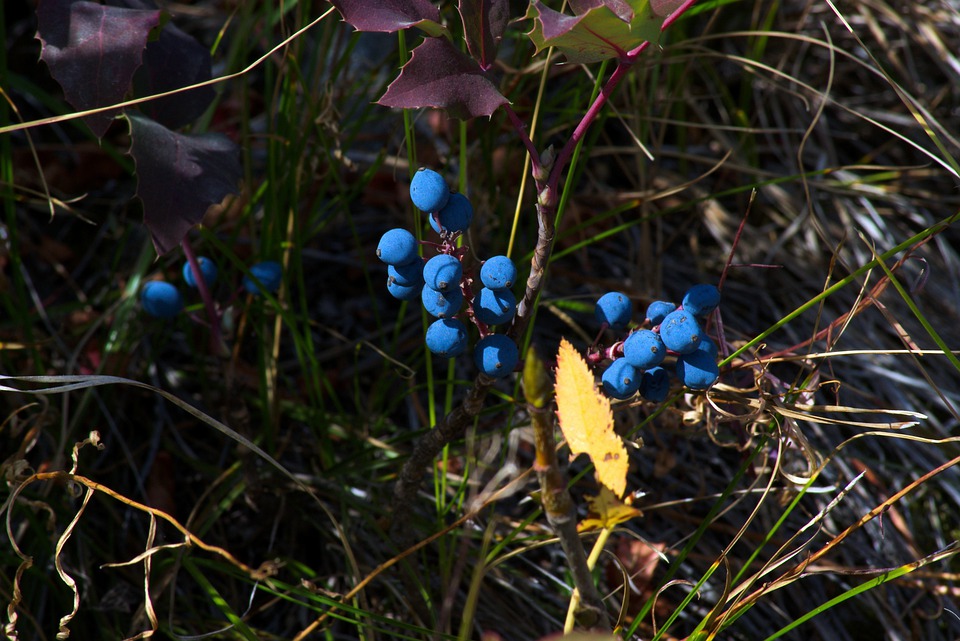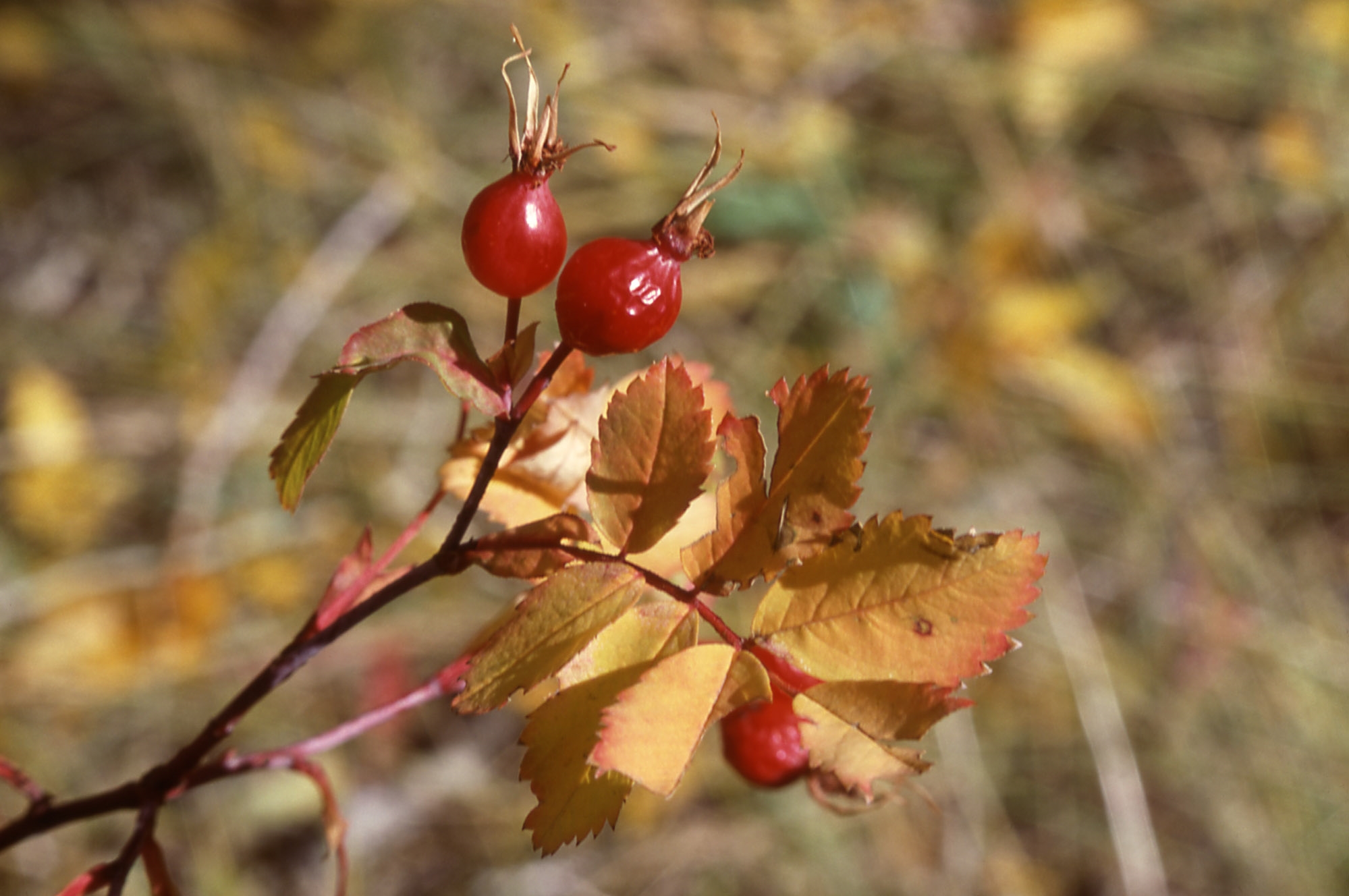
Mahonia repens
Producing Blue Berries in the Grand Tetons
Courtesy Pixabay, Mike Goad, Photographer,
 Red Raspberry
Red Raspberry
Rubus idaeus var. strigosus
Courtesy NPS, Yellowstone’s Photo Collection, JW Stockert Photographer, 1972
 Thimbleberry
Thimbleberry
Rubus parviflorus
Courtesy NPS, Yellowstone’s Photo Collection, JW Stockert, Photographer
 Utah-Serviceberry
Utah-Serviceberry
Rosaceae Amelanchier utahensis
Courtesy National Park Service, Lee Ferguson, Photographer
 Rose Hips
Rose Hips
Wood’s rose Rosa woodsii
Courtesy NPS, Yellowstone’s Photo Collection, J Schmidt, Photographer, 1977The berry season is upon us- huckleberries, raspberries, gooseberries, chokecherries (not a berry but close enough), elderberries, bearberries, while early berries have faded- golden current, serviceberries, thimble berries are now fruit leather.
Berry picking during my youth in the North woods of Wisconsin was a wonderful tradition that I, and our black bear neighbors, looked forward to with great anticipation. We often shared the same patch evident by fresh bear scat and tracks. Those rare occasions where brother and sister bear were with us are frozen in time. “Just keep picking and talking- they won’t bother us.” My grandmother’s refrain. I was enthralled, watching every move and sound they made, with an occasional “woof” from mother bear alerting the youngsters.
Now, so many years later, I take my students to the Tetons hoping for a glimpse of bruins harvesting berries, rose hips, and thorn apples along streams and roadsides. Black bears are efficient berry-eaters, consuming up to 30,000 berries a day in a good year. They gather berries quickly, using their sensitive, mobile lips swallowing them whole. The berries enter a two-part stomach, which grinds the pulp off the seeds which pass through unbroken and are able to germinate, making black bears important seed dispersers.
Our Bear River Range here in Northern Utah was once a stronghold for the bruin. Overharvesting by hunters and the government has left it wanting, but the berries remain. One berry favored by bears is the white snowberry. Don’t copy the bears on this one as it’s toxic, but a great medicinal. Another that I avoid is the buffalo berry, called soapberry in the northwest. It contains saponin, the active ingredient in most soaps. It’s much like biting into a bar of soap, applied in my younger years for mouth cleansing. And please avoid the voluptuous red and white fruit of the bane berry, and cute little mini tomatoes of deadly night shade. You will be all the better for it.
“Harvesting berries can be a powerful meditation, centering us in the power of “now,” and is one of the oldest human experiences. This simple action can be an opportunity to revel in the abundance of nature. Tangibly interacting with food that is so wired into its life source is otherworldly, and it reminds us of a time when humans were more directly connected to the origins of our food. It is a grounding experience that demands every cell in your body resonate with the source of our food, catalyzing our connections to the universe.” Valerie Segrest quote
I strongly recommend “Blueberries for Sal” for younger generations. A delightful 1948 children’s book by renowned author Robert McCloskey. I recently visited the Blueberry Hill in Main’s Acadian N.P., the location for this story, and picked a few myself. Unfortunately, the bears had been replaced swarms of tourists!
Jack Greene for Bridgerland Audubon Society, and yes, I’m wild about Utah’s bears and wild berries!
Credits:
Pictures:
Oregon Grape Producing Blue Berries in the Grand Tetons, Courtesy Pixabay, Mike Goad, Photographer, https://pixabay.com/photos/blue-wild-berries-in-the-tetons-blue-3842367/
Red raspberry (Rubus idaeus var. strigosus); JW Stockert; 1972, Courtesy NPS, Yellowstone’s Photo Collection, https://www.nps.gov/features/yell/slidefile/plants/rosefamily/Images/08720.jpg
Wood’s rose (Rosa woodsii) hips; J Schmidt; 1977, Courtesy NPS, Yellowstone’s Photo Collection, https://www.nps.gov/features/yell/slidefile/plants/rosefamily/Images/06964.jpg
Thimbleberry (Rubus parviflorus); JW Stockert; 1973, Courtesy NPS, Yellowstone’s Photo Collection, https://www.nps.gov/features/yell/slidefile/plants/rosefamily/Images/08718.jpg
Utah Serviceberry, Rosaceae_Amelanchier_utahensis, Courtesy US NPS, Lee Ferguson, Photographer, https://www.nps.gov/arch/learn/nature/images/Rosaceae_Amelanchier_utahensis.jpg
Audio: Courtesy & © Friend Weller, https://upr.org
Text: Jack Greene, Bridgerland Audubon, https://bridgerlandaudubon.org/
Additional Reading: Lyle W Bingham, Webmaster, and Jack Greene, Author, Bridgerland Audubon, https://bridgerlandaudubon.org/
Additional Reading:
Jack Greene’s Postings on Wild About Utah, https://wildaboututah.org/author/jack/
Valerie Segrest, Foods Still Matter: The Muckleshoot Food Sovereignty Project, National Museum of the American Indian, The Smithsonian Institution, 2018, https://americanindian.si.edu/nk360/pnw-history-culture/muckleshoot
Valerie Segrest, Food sovereignty, TEDxRainier, TEDxSeattle, https://tedxseattle.com/talks/food-sovereignty/
McCloskey, Robert(Author), Blueberries for Sal, Puffin Books, September 30, 1976 https://www.amazon.com/Blueberries-Sal-Robert-McCloskey/dp/014050169X
A Bear’s Menu, Student Activities, Educator Resources, Yellowstone National Park, https://www.nps.gov/teachers/classrooms/a-bears-menu.htm
